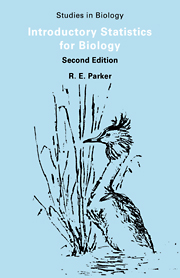Book contents
- Frontmatter
- Contents
- How to use this book
- 1 Probability and Statistics
- 2 Continuous Distributions: Confidence Limits
- 3 Continuous Distributions: Tests of Significance
- 4 Discontinuous Distributions: Binomial Distribution
- 5 Discontinuous Distributions: Poisson Distribution
- 6 Analysis of Frequencies: Single Classification
- 7 Analysis of Frequencies: Double Classification
- 8 Interrelationships of Quantitative Variables
- 9 Analysis of Variance: Single Classification
- 10 Analysis of Variance:Double Classification
- Solutions to Problems
- Further Reading
- Selected Statistical Tables
8 - Interrelationships of Quantitative Variables
Published online by Cambridge University Press: 05 June 2012
- Frontmatter
- Contents
- How to use this book
- 1 Probability and Statistics
- 2 Continuous Distributions: Confidence Limits
- 3 Continuous Distributions: Tests of Significance
- 4 Discontinuous Distributions: Binomial Distribution
- 5 Discontinuous Distributions: Poisson Distribution
- 6 Analysis of Frequencies: Single Classification
- 7 Analysis of Frequencies: Double Classification
- 8 Interrelationships of Quantitative Variables
- 9 Analysis of Variance: Single Classification
- 10 Analysis of Variance:Double Classification
- Solutions to Problems
- Further Reading
- Selected Statistical Tables
Summary
Kinds of information and relationships
There are two main kinds of information that we may have about a series of individuals or samples. One kind consists of measurements, counts, scores, etc., which take the form of a numerical assessment. We call this quantitative information. The other kind consists of a classification of the individuals or samples into a series of qualitatively different categories. We call this qualitative information. We can examine interrelationships for any of the three possible combinations thus, qualitative/qualitative, qualitative/quantitative, and quantitative/ quantitative. As we shall see, in practice, the situation is more complex because the categories used in the qualitative classification may form a semi-quantitative series. Again, even when a numerical assessment is not made, it may still be possible to arrange the individuals or samples in order on the basis of a particular criterion, i.e. to rank them.
Qualitative/qualitative data
Interrelationship based on qualitative information is usually called association and examined by means of a c × r table as described in Chapter 7. We calculate χ2 with (c - 1)(r - 1) degrees of freedom and this permits us to test the association for significance. The χ2 value itself is not a good measure of the closeness of association as its magnitude depends on the total number of observations. To compare the levels of association for two tables with the same number of degrees of freedom we use χ2/n, the ‘mean-square contingency’.
- Type
- Chapter
- Information
- Introductory Statistics for Biology , pp. 55 - 67Publisher: Cambridge University PressPrint publication year: 1991



